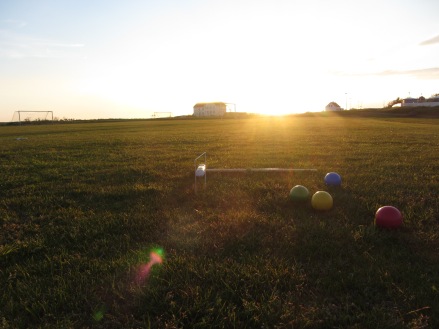We recently celebrated midsummer here, and I wrote about it, as well my general sense of the summertime spirit here in Iceland, for my most recent column in The Island Review. The full piece can be read on their website, but here’s an excerpt:
“Happy summer solstice,” I wished a southerly-dwelling friend of mine this weekend. “I had no idea,” she said, wishing me a happy day in return. “Do you have any local traditions to take part in?”
Now, if you’re talking about traditions along the lines of those our Nordic neighbors partake of during the midsummer season — dancing around maypoles, donning floral crowns, lighting bonfires, and consuming large quantities of fermented fish — the answer is no. (Bonfires are a popular New Year’s tradition here, but the opportunity to freak out a foreigner is generally excuse enough to bust out the fermented
fishshark.)Rather, I’d say that summer is more of a state of mind in Iceland than it is a season, or a holiday, or a set of prescribed traditions. There’s a kind of urgency accompanies the sudden shift from near-constant darkness to near-constant daylight, a sense that while it may not exactly be warm, this is the time to go out and make the most of what several of my coworkers and acquaintances have referred to as “fallegt land okkar”—our beautiful country. Suffice to say, out of office auto-replies are quite commonplace from April to September.
There’s a snippet a little further on, too, which recalls a summer afternoon last year, and which can be nicely augmented by some throwback photos:
I distinctly remember a Saturday later that same summer, notable because it was the only day that season that I was able to sit outside in a sleeveless shirt for more than half an hour. I was out with a group of friends, and making our way to a park, we passed street musicians, people selling crafts, and even a giant inflatable swimming pool where kids zipped up into giant plastic balls could gambol about like bubble-encased sumo wrestlers. Arriving at the park, itself surrounded by cafés with outdoor seating, we plonked ourselves down on the grass, and (excepting a brief and enterprising run to a nearby Vínbuð for a few cans of beer), didn’t move for the next three hours.
Around us, however, the air was almost literally buzzing with excitement. Every single café table and chair was filled. There were guys strumming guitars, their classic rock covers mingling with the sound of tinny pop music as teens tried to get as much volume as possible out of their phones. Not one, not two, but three bachelorette parties — each with increasingly antic displays of pre-marital liberty — trooped through the clusters of people lounging on the grass. A coworker on her way to a barbeque sat down with us for a bit and debated whether it might not be better to go straight to the beach instead, or maybe she could do both? A young girl walking a bunny on a leash skipped by. Children scrambled up to the tip top of a statue and whooped.
So, enjoy a little piece of summer in Iceland. And after, if you’re hankering for some more midsummer (and midsummer-adjacent) photos, I’ve posted a few on the new and improved photo blog, here.
Happy summer, everyone!












